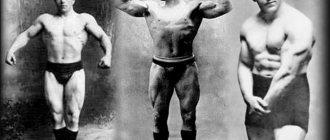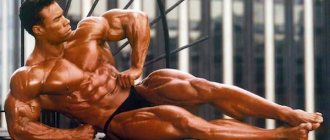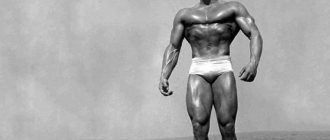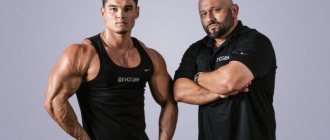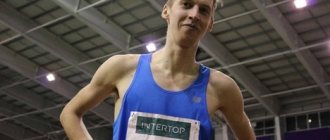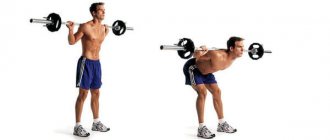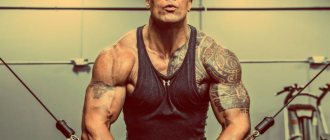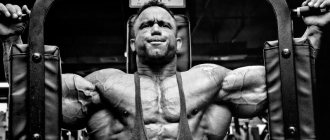Absolute Mr. Olympia and his program.
Lee Haney's video workouts are full of positivity. The bodybuilder not only is not afraid of difficulties, but also helps his players to improve their morale. He alternates encouragement with clear instructions. Each of his steps is precise and rhythmic, Lee does not make unnecessary body movements, due to which time is saved and it becomes possible to increase the number of approaches (sets). The secret of success of this titled athlete lies in the high volume of training.
Biography of Lee Haney
Lee Haney (real name of the champion Lee Marvin Haney) was born on November 11, 1959 in South. Caroline is in a religious family.
- From an early age the boy was fond of sports. At first it was football, and later I became interested in weightlifting.
- Lee grew up with faith in a higher power, and promised God that if he could help him win in competitions, then he would put all his success in the service of God. And from then on, he was literally pursued by luck. At the age of 19, he won the Mr. America youth tournament for the first time, then the junior competition, and later received the title of Mr. Universe. Brilliant victories contributed to Lee becoming a zealous Christian.
- Lee became a professional athlete in 1983.
- The athlete wanted to end his sports career at the age of 32, retraining as a businessman. The star athlete opened several fitness centers, from which he made a good fortune. Leaving big sports, he was already the owner of 4 gyms, a lecturer for believers and athletes, a television and radio host.
- The bodybuilder spends the lion's share of his income on a special settlement for children deprived of parental care. The guys there live in good conditions, eat normally and play sports.
- As for his personal life, he met his only wife Shirley Haney at the age of 6 at school, after which they were friends for a long time and got married. The bodybuilder’s family has two children: daughter Olympia and son Joshua.
Lee Haney's best trophies
Lee Haney is now considered one of the world's most decorated bodybuilders. His name is known to any self-respecting athlete.
- Throughout his career, he showed himself in 22 of the most important tournaments, each time his result was not lower than 3rd place.
- Debut victory 1982 - World Amateur Championship "Heavyweight".
- “Nationals” tournament in 1982 - as a result, he became the champion both among heavyweights and in the absolute category.
- In 1983, the athlete participated in 8 tournaments. “Grand Prix Las Vegas” (1st place), “Grand Prix of England” (2nd place), World Professional Championship (3rd place), “Mr. Olympia” (3rd place), “Grand Prix of Sweden” (2nd), Switzerland (3rd), “Grand Prix World Cup” (2nd).
- Haney became Mr. Olympia 8 times from 1984 to 1991. It is interesting that the athlete wanted to end his career back in 1990, so as not to overshadow the famous Arnie, but the last victory in 1991, according to the athlete himself, was easier for him than others.
- 1987 - “German Grand Prix”.
Body-building
Since the early 1980s, Haney began to participate in the most important bodybuilding tournaments and did not fall below 3rd position. In 1984, the man became Mr. Olympia for the first time and received the statuette 8 times, stopping in 1991. In terms of the number of titles, he surpassed the famous Arnold Schwarzenegger, whom he once looked up to just like Sergio Oliva. Only Ronnie Coleman in 2005 was able to repeat Lee's record.
Great to meet up with 8 x Mr O Lee Haney… Chatting and laughing now the competitive days are over… Mutual respect ✊
Posted by Dorian Yates Sunday, September 15, 2020
Lee Haney and Dorian Yates
During his competitive years, the bodybuilder weighed 112 kg with a height of 180 cm, and his biceps girth was 51 cm. Haney leaned on high-volume training, unlike Dorian Yates, who insisted on working until “failure.” The American believed that a large number of repetitions stimulates the muscles, while training to the limit begins to burn them.
After finishing his competitive career in 1991, the athlete went into business, opening a chain of gyms, where he was engaged in coaching and consulting.
Lee Haney's Training Principles
Lee Haney's training has always been high-volume, since it was this principle that had the most beneficial effect on the athlete's form.
- At the beginning of his journey, Haney used several training systems, but concluded that classes with an increased number of approaches suited him best.
- The champion did not support the advice of his colleague Dorian Yates, who always advocated working “to failure”; in turn, Lee Haney believed that such a method would only “burn” muscle mass.
- Lee preferred machines and pulleys to free weights. This approach allows the bodybuilder to feel or isolate the target muscle group.
- And while the champion did pay attention to exercises with weights, he performed an unrealistic number of approaches. Up to 35 times on target muscle groups, performing 8-10 repetitions. Countless repetitions and sets meant high intensity, otherwise a simple workout could drag on for several hours.
- To reduce training time, the athlete rested only 45 seconds between sets.
- Sports injuries, which you can find out about here, were unknown to Lee, since he warmed up for a long time, very carefully selected working weights, smoothly moving from training to main ones. Therefore, Lee Haney’s program did not include heavy bench presses, deadlifts, or low-repetition squats.
- Photos of Lee Haney look decent even in the off-season, since the bodybuilder has always done cardio and was passionate about proper nutrition.
- Execution technique has always been in the first place for the athlete. Every movement of the champion is always clearly thought out, there is no rush or cheating.
Recommendations
- The spine is stable, it is better not to make movements in the hip joints, removing the buttocks from the path of movement of the bar. It is recommended to slightly bend forward to make the movement more uniform and smooth;
- It is better to pull the Haney row to the upper part of the lower back, that is, in the deepest possible amplitude, and at the same time control the position of the body so as to avoid helping yourself by changing the angle of the spine;
- At the extreme point of amplitude, the elbows should look up, and the angle of flexion at the joint should be acute;
- To perform this deadlift correctly, you need good muscle awareness. Ideally, the movement begins at the shoulder joint and is initiated by the rear deltoid, with the elbows then bending. Those who bend their elbows first transfer some of the load to the biceps;
- It is also not allowed to work at the expense of the wrists; it is better not to bend them too much, because this shifts the emphasis to the forearms.
Lee Haney Workout Program
The champion's workout for the shoulders and back looks like this:
Shoulders (sets/reps):
- standing barbell press (for front and middle deltoids) - 5/10;
- Dumbbell lateral raises (standing swings) - 4/10;
- row with a narrow grip of the barbell to the chin - 4/8-10;
- Raising arms to the sides with dumbbells in an inclined position for the rear deltoids - 4/10.
Back:
- traction to the chest of the upper block - 4/10;
- bent over barbell straight grip row - 4/10;
- seated pull-down of the lower block from the waist - 4/10;
- deadlift with dumbbells 4/10;
- Bent-over dumbbell row - 4/10;
- shrugs (for trapezius) - 4/8-10.
The selection of exercises covered both the arms and the back, so there was no disproportion in the athlete’s body, which made his form ideal.
Execution technique
Initial position
- Set the Smith machine bar at a height that matches the length of your arms;
- Stand with your back to the machine, stabilize your lower back by drawing in your stomach;
- Move your shoulders away from your ears, lowering your shoulder blades toward your pelvis and slightly contracting your diamond shape;
- Grab the bar symmetrically with both hands;
- The distance from each palm to the stands should be the same;
- The grip should be made in such a way that bending at the elbow joint is comfortable;
- For most people, this is a grip 10cm wider than shoulder width;
- Remove the bar from the belay supports by simply turning it towards you
Movement
- Bending your arms at the elbow joints, pull the bar up as far as possible;
- The elbows should bend at the same time;
- In order to ensure sufficient amplitude, raise your shoulders and engage your trapezius;
- The buttocks can become an “obstacle” in the way of the bar, so it is allowed to slightly push the barbell back;
- Lowering the bar should be slow;
- The thrust is accomplished through the rear deltoid, the trapezius only helps the movement;
Deadlift by Li Hanei. Or as they also say - Lee Haney-Honey deadlift with a barbell for the rear delts and trapezius
Errors
- The athlete's chest is strongly curved, his back is round;
- The lumbar region is either too arched or curved, there is no stability in it, the spine changes angle with each pull;
- Instead of deadlifts, the athlete does shrugs with a barbell behind his back, that is, he lifts and lowers the weight by lifting his shoulders;
There is a separate category of exercises that are most convenient to perform with a fixed barbell, that is, in a Smith machine. This movement falls into this category. Pulling free weights is not convenient, if only because it requires a tilt of the back, and to stabilize the bar you will have to engage the triceps, which will complicate the exercise and make it less accessible. You can do a crossover Haney row by attaching a long handle to the lower block, but this option also requires good coordination.
Lee Haney now
- Until now, the athlete maintains excellent shape, as evidenced by the photos from 2020, in which he looks fit and fresh.
- Lee conducts various seminars, writes books, and is a member of the World Bodybuilding Federation.
- During the administration of President Bill Clinton, Lee served as a representative of the President's Council on Sports Development.
- The entire professional bodybuilding community calls him a professor, as he is still a member of the Sports Science Association.
- Lee Haney works part-time as the host of a religious show on the Trinity TV channel, and also hosts programs on sports and fitness.
- The athlete constantly talks about proper nutrition, training and healthy lifestyle, which is a great motivation for beginners.
In the video below, the Olympia champion will share with readers the secrets of his success. What is your opinion on Lee's achievements? In your opinion, was this champion able to outshine Iron Arnie? Write your opinion in the comments.
Analysis of the exercise
Many bodybuilders mistakenly classify the Lee Haney deadlift as an isolation exercise. It is not right. In fact, it is a complex row for developing the trapezius and deltoid muscles, with an emphasis on the rear deltoid. It follows that a slight lift of the shoulders in the exercise is not a significant technical error. A significant emphasis on lifting and performing in the shrug style makes it difficult to concentrate on the goal.
Sometimes the movement is performed with dumbbells, this allows you to overcome the natural asymmetry in the development of the human body. But in most cases the movement is performed in a Smith machine.
For Smith, the following layout of working muscles is advisable:
- Trapezius and rear deltoids as prime movers;
- The levator scapulae and rhomboid muscles contribute to movement;
- The biceps and the entire complex of leg muscles, as well as the abs, stabilize the position of the arms and body;
- An exercise with a strong forward bend also involves the quadriceps in a static manner.
Lee Haney Row / Pumping up the rear delts
There are two polar opinions here. Some experts believe that the best preparation is a set of pull-ups with a reduced amplitude, plus a joint-type warm-up of the shoulder girdle and light stretching. Others believe that the warm-up should include 1-2 sets of standing or bench presses, since the deltoids will be a priority. The second opinion is more scientifically substantiated, but in the practice of bodybuilding and fitness both options are found.
Warm-up sets for this exercise are mandatory; beginners should strive to perform them with minimal weight. For most people, a light stick or body bar is suitable. Sometimes it is recommended to warm up with dumbbells, although biomechanically this movement will be somewhat different.
- The emphasis in movement is on working the shoulders and trapezius, rather than the elbows and biceps. Start of movement - from the shoulders;
- The head should not lie on the chest, and the neck should not bend forward;
- Natural deflection in the lower back is allowed, but should not be hypertrophied;
- The shoulders are engaged when the elbow has not yet begun to bend; bending the elbow is the second phase of the exercise;
- The arms at the extreme point must be straightened completely. The movement behind the back assumes a short amplitude and does not contribute to its increase, so you need to consciously increase the amplitude and increase muscle stretching due to this;
- At the top, the elbows should be raised and close to each other, this contributes to the correct distribution of the load and allows you to perform the exercise with the correct mechanics;
- It is important to synchronize movement with breathing. There can be two options - holding your breath while ascending or exhaling while ascending; you need to choose the most convenient one;
- The exercise is performed in a fairly large number of repetitions, so you need to try not to change the angle of the spine and keep the amplitude the same;
- It is not recommended to change your grip during training; sometimes it turns out that the athlete does not grip the bar comfortably, and he has to move his palms, but it is better to avoid this
Errors
- Excessive deflections and humps in the spine;
- “Inserting” the elbows at the bottom of the exercise;
- Body building and cheating;
- Movement due to shoulder shrug;
- Hasty work without delay at the top of the amplitude;
- Disproportionately heavy weights
Recommendations
The grip allows you to work with your hands under your shoulders or in a position slightly wider than your shoulders. This work allows the athlete to avoid overloading the joint. A narrower grip is not recommended due to the anatomically unnatural position of the shoulders.


